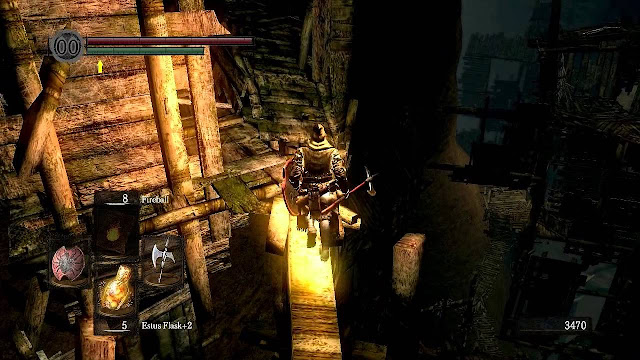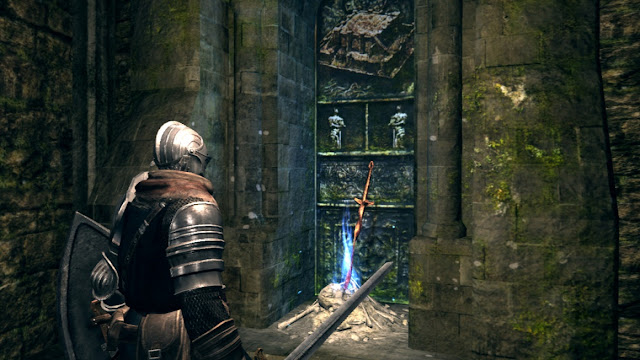Review by Matt S.
Dark Souls: Remastered really, really needed to release at the same time on the Nintendo Switch. That’s where the novelty of the re-release was: for the first time we were going to be able to play Dark Souls on a handheld. That was a really exciting prospect. But the Switch version is a while away yet, and so here we are reviewing a conundrum: Dark Souls Remaster isn’t much of a remaster, but it’s also the best Dark Souls game, by a considerable margin.
Regarding the remaster itself; this is the vision of Dark Souls that the developers clearly had in mind when setting out to make the original game back in 2011. The frame rate is smooth – yes, even in Blighttown, a nightmare of a name that will only make sense to existing Dark Souls fans, but if you’re new to this game, be glad that it maintains a glistening 60fps down there (and this coming from someone who genuinely doesn’t generally care about frame rates). There’s also a resolution jump from 720p to the full 1080p, but that’s rather pointless since the game’s art assets were designed with 720p in mind, so in fact Dark Souls still looks more than a little bland in comparison to the third game in the series.
Or at least, it does on a technical level. Dark Souls’ strength was never in the polygons it was pushing. It was in the art layered over the polygons, and the mesmerising vision that drove the developers through the original development is still incredible to behold today. Melancholia absolutely drips from the aesthetics that this game uses. A drudgy, dreary dankness that, in the hands of lesser artists, would have simply been boring. Here the environments, enemies, and locations carry a gothic gravitas; a sense of ruined majesty that tells a story all in itself, and makes pushing through one punishing area after another all worthwhile, just to see what is coming next.
The level design is also unparalleled, even when compared to the sequels. The reason that I will forever remain a Demon’s Souls purist (and before it King’s Field, the “Souls predecessor”) is because the intricate, winding passageways, filled with secrets and surprises, was so perfectly constructed. Unlike later games, there was less of a sense of signposting, so you didn’t always know where you needed to go next, and that gave Demon’s Souls a near perfect sense of Dungeons & Dragon-style exploration. You’ll be deep in a mouldering labyrinth, and the dungeon master is telling you there are two directions you can go. Just trying to pick the “right” direction, or even alternatively deciding to look around for a secret door, was a monumental decision when you knew that the wrong choice would lead you straight into the jaws of a dragon. Dark Souls continued the good work Demon’s Souls did there, but layered over it a greater accessibility to people who were less purely interested in dungeon design, and that’s essentially the reason the franchise launched itself into the stratosphere.
Later Dark Souls games worked hard to make the combat the challenge; giving you more options but making the enemies more varied and skill-based challenging in kind. The original Dark Souls, and Demon’s Souls before it, made the journey the challenge. Combat was part of it, but every step had weight, every doorway purpose, and every secret was a meaningful reward. Later Dark Souls were very fine games, don’t get me wrong, but I feel the developers got so wrapped up in the combat side of things that they lost sight of the journey being the real Dark Souls experience. Only slightly, mind you, but enough so that I still believe that Dark Souls is the ultimate realisation of what really makes Souls special.
Storytelling is another real highlight of Dark Souls, and having not played the game for a half decade or so, to step back in and find it fascinating all over again is a testament to just how sublime the story really is. What I love about it – and indeed love about all the Souls games – is that they make you work for them. If you’re not paying attention you’ll cruise through the game without it ever really registering that there’s a story in there, but if you take the time to read the descriptions on artifacts, notice details in the environments, and really focus on every word that the rare NPC imparts to you, Dark Souls quickly becomes the textbook perfect example of how to craft a rich narrative through multiple storytelling techniques, and how games can adopt the superior “show, don’t tell” principle of storytelling.
Combined, the storytelling, environments design, and combat weave a perfect – not near perfect, actually perfect – gothic story that calls to mind the elegant prose of Edgar Allan Poe, combined with the menace of Bram Stoker’s Dracula. It’s not a relaxing game to play by any means, but Dark Souls is majestic and beautiful.
Players who came to the Souls games in the later entries may find Dark Souls to be a bit limited in some areas. Combat options are more limited. Bosses are imposing, but lack some of the intricate design and flowing attack patterns that made bosses in later Souls games such elaborate puzzles to sort though. You’ll still face a steep challenge, but insofar as a Souls game can have a “standard” or “baseline” approach to boss design, this one is it.
I’d also suggest that while the environment and level design is near-perfect, the placement of enemies can be a little cheap at times. Boss battles might be amazing experiences, but Dark Souls relies on hidden enemies or enemies jumping out of hidden spaces at you one too many times. Later games smooth over that tendency to continue to surprise and threaten players, but do so in a way that doesn’t feel quite so cheap.
It’s impossible to talk about Dark Souls other than in the context of what that game led to. Should you play Dark Souls? Absolutely. It’s one of the most potent, influential games of all time, and anyone who cares about the heritage and ongoing history of game developer needs to study this one closely as a landmark masterpiece. Furthermore, Dark Souls does some things – such as storytelling and world design, with a purity of vision that even its own sequels haven’t been able to top.
But with all of that said, it’s still only the slimmest of steps up from what most people who are interested in Dark Souls have already played to death back on the PlayStation 3. As I said at the start of the review, this remaster really needed the novelty of the Nintendo Switch handheld portability to provide the definite hook to justify a re-purchase.
– Matt S.
Editor-in-Chief
Find me on Twitter: @digitallydownld
 |
| Please Support Me On Patreon!
|











